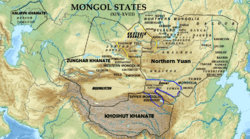Upper Mongols
| Regions with significant populations | |
|---|---|
| 100 000 (2009) | |
| Languages | |
| Khoshut dialect of Oirat Mongolian | |
| Religion | |
| Tibetan Buddhism and Shamanism | |
| Related ethnic groups | |
| Oirats, Mongols, Mongols in China | |
The Upper Mongols (Mongolian: Deed mongol Дээд монгол, Mongolian Script: ᠲᠡᠭᠡᠲᠦ ᠮᠣᠩᠭᠣᠯ), also known as the Köke Nuur Mongols (Mongolian: Хөх нуурын Монгол, Mongolian Script: ᠬᠦᠬᠡ ᠨᠠᠭᠤᠷ ᠮᠣᠩᠭᠣᠯ, "Blue lake Mongol") or Qinghai Mongols (Chinese: 青海蒙古) are ethnic Mongol people of Oirat and Khalkha origin who settled around Qinghai Lake in so-called Upper Mongolia. As part of the Khoshut Khanate of Tsaidam and the Koke Nuur they played a major role in Sino–Mongol–Tibetan politics during the 17th and 18th centuries. The Upper Mongols adopted Tibetan dress and jewelry despite still living in the traditional Mongolian ger and writing in the script.
History
After the disintegration of the Mongolic[1][2][3]Xianbei state, nomadic groups such as the (Monguor) migrated under the rule of their Khan, Tuyuhun, from their original settlements on the Liaodong Peninsula to the eastern region of modern Qinghai.[4] The Tuyuhun Empire (284-670) stretched 1,500 kilometers from east to west and 1,000 kilometers from north to south.
Although, the Mongols of the Gansu–Qinghai Lake areas under the rule of the Yuan dynasty submitted to the Ming dynasty after the Yuan dynasty's fall in 1368, the Upper Mongols came there in 16th and 17th centuries. Many Mongol emperors and rulers of the Northern Yuan dynasty such as Dayan Khan, Ligdan Khan, the Ordos and Tümed princes invaded, or took refuge, in Qinghai from 1509-1632. The Tümed Mongols ruled in the Ordos region and they gradually extended their domain into northeastern Qinghai.[5]
The Khoshut's leader Toro Baikhu Güshi Khan defeated all the Dalai Lama V's enemies in 1637-1642. He was enthroned by the Dalai Lama as Khan of Tibet. His grandson and second successor Gonchug Dalai Khan (1669–98) welcomed dissident Dzungars when Galdan Khan began despising Guushi Khan's Oirats.

With the defeat of Galdan in 1697, Dalai Khung Taiji Dashi Batur submitted to the Kangxi Emperor of the Qing dynasty in a personal audience. In 1705, with the approval of the Kangxi Emperor of the Manchu Qing dynasty, Lha-bzang Khan of the Khoshud deposed the regent and sent the 6th Dalai Lama to Beijing; the 6th Dalai Lama died soon after, probably near Qinghai Lake (Koko nur) in Amdo. The Dzungar Mongols invaded Tibet in 1717, and held the entire region until their final defeat by the Qing imperial army in 1720.,[6] thus began the period of Qing rule of Tibet.
The Upper Mongolia or the Khoshut Khanate was conquered in 1717 and 80,000 people were killed.[7] By that period, Upper Mongolian population reached 200,000. The Upper Mongols revolted against the Manchu Qing dynasty under rule of the prince Lubsan Danzan in 1723 but they were defeated. Lubsan Danzan was killed by the Manchus in 1755.
The Upper Mongols in Northwest China revived their cultural ties with Inner Mongolia with the liberalization in 1979. The Tibetan culture strongly influenced them, however they use Mongolian script unlike other major Oirat tribes that use Zaja Pandita's Todo Bichig Clear script.

The separation of the Tibetans from the Mongolian banners weakened the Upper Mongols. After 1775, the Tibetans made increasingly bold attacks on the Mongols. Hence, small group of the Upper Mongols fled to Gansu to escape the Tibetan nomads and they formed Subei Mongol county. In 1821 the Tibetan nomads made a mass migration north, sweeping away the Qinghai Mongol banners between the Yellow River and Qinghai Lake due to the internal strife between the Tibetans. In 1897 the Hui Muslims plundered the Upper Mongols.
Ethnic groups of the Upper Mongols
All Upper Mongols are not khoshut oirats and there are few khalkha, choros and torghuts.The Ligdan Khan came here with 150-200 000? Chahar people (30-40 000 soldiers) and his ally Tsogt Taij came with 40 000 Khalkha soldiers but 70%-90% of them killed by disease and the Güshi Khan's army.The Upper Mongolia had 29 hoshuns[8] (21 Khoshut, 2 Choros, 4 Torghut, 1 Khalkha) in the early 20th century.Now there are 9 hoshuns of the Upper Mongols.80-90 000 Upper Mongols live in the Qinghai and 10 000? Upper Mongols live in Subei Mongol Autonomous County (2010).
References
- ↑ Roger, Blench. Archaeology and Language II: Archaeological Data and Linguistic Hypotheses. Retrieved 12 March 2015.
- ↑ Hyun Jin, Kim. The Huns, Rome and the Birth of Europe. Retrieved 12 March 2015.
- ↑ Rachel, Lung. Interpreters in Early Imperial China. Retrieved 12 March 2015.
- ↑ The T'u-yü-hun from the Northern Wei to the time of the Five Dynasties, p. XII. 1970. Gabriella Molè. Rome. Is.M.E.O.
- ↑ W.D.Shakabpa, Tibet: A Political History
- ↑ Richardson 1986, pp. 48–49
- ↑ БУЦАЖ ИРЭЭГҮЙ МОНГОЛ АЙМГУУД (Mongolian)
- ↑ Хөх нуурын Монголчууд буюу Дээд монголчууд гэж хэн бэ? (in Mongolian)
